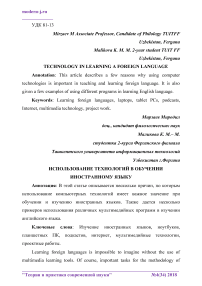Technology in learning a foreign language
Автор: Mirzaev M., Malikova K.M.M.
Журнал: Теория и практика современной науки @modern-j
Рубрика: Основной раздел
Статья в выпуске: 4 (34), 2018 года.
Бесплатный доступ
This article describes a few reasons why using computer technologies is important in teaching and learning foreign language. It is also given a few examples of using different programs in learning English language.
Learning foreign languages, laptops, tablet pcs, podcasts, internet, multimedia technology, project work
Короткий адрес: https://sciup.org/140273125
IDR: 140273125
Текст научной статьи Technology in learning a foreign language
Learning foreign languages is impossible to imagine without the use of multimedia learning tools. Of course, important tasks for the methodology of teaching foreign languages include providing opportunities to illustrate the actual process of communication in English, and creating an educational environment that provides real conditions for learning use of the target language and its culture.
Technology is very important part of our live in different levels. We are as likely to find it in the primary sector as much as in adult education.
Modern educational technologies are used to make the communicative competence of a schoolchild in learning another language and concurrently they are the most productive for creating an educational environment It is evident that using any one technology of education, no matter how perfect it is, will not create the most effective conditions for the disclosure and development of students' abilities and creativeness of a teacher [1].
Teachers should try miscellaneous resources of podcasts. Traditional course books usually offer gap filling and true or false exercises, which do not really give a sense of real communication. Students very often complain that audios going along with course books seem to be artificial and fake. Fortunately, a wide range of free podcasts made specifically for language learners, we can easly find them on iTunes, YouTube, SoundCloud etc. A majority of young students have access to, and are actually fond of using the Internet as much as possible. In this case the teacher can use countless resources with online games, which stimulate and improve every aspect of language skills. The Internet provides the classroom environment with a diverse range of games that are free and available for everyone. The teacher might even display these games on the interactive whiteboard and engage the whole class.
Blogging platforms such as Blogger, or WordPress, give students an opportunity to create blogs for free. Sometimes students find blogging encouraging because they can write about anything they find interesting. The fact that not only the teacher can read their virtual journals, but basically everyone with the access to the Internet, makes them put more effort into writing. [2].
Multimedia technology acts as a special intellectual activity, which means it has a number of advantages compared with other information technology training:
-
1. The pedagogy means continuous improvement of content and methods of education in modern conditions.
-
2. Provides opportunities to identify and support students with linguistic abilities.
-
3. Represents the basis of distance learning.
-
4. Provides access to best practices in education and training of the general public through the educational world of the Internet and an extensive communication network.
-
5. Creates an artificial language environment, allowing the study of foreign languages (FL) at students’ own pace, increasing the independence and responsibility of students when organizing FL training for all age groups. Allows building FL training in accordance with student interests and goals, and allows students to enter into training in the intercultural component of FL.
-
6. Multimedia technology is new and apparently has limitless possibilities for creation of means of graphic clarity.
Multimedia (computer with additional devices) can be a powerful tool for everyone to learn foreign languages through self-study, and allow close monitoring and ongoing operational support [3].
Along with positive aspects, there are some negative trends affecting the mass creation and implementation of multimedia technology in the learning process. These include:
-
1. Lack of ability of existing education systems to make active use of multimedia technology, and to integrate it into the educational process and its organization;
-
2. Lack of qualified developers;
-
3. Lack of a developed methodology of multimedia technology;
-
4. Lack of financial resources for the creation and widespread adoption of multimedia technology;
-
5. The device is not designed evaluation [3].
Another area that technology supports very effectively is project work. Getting learners to do work about topics that are of interest to them, or topics that are taught in other parts of the curriculum (sometimes called Content and Language Integrated Learning or CLIL ) is a great way to improve their skills. Technology makes this possible wherever you are in the world. Teachers and learners can go online to read or listen to material about different areas of interest, and can then write or speak about what they have discovered, telling others in the class or other classes elsewhere in the world [4].
Список литературы Technology in learning a foreign language
- Раджабова Д. А. Modern educational technologies in teaching a foreign language // Молодой ученый. - 2017. - №13. - С. 592-595. - URL https://moluch.ru/archive/147/41269/ (дата обращения: 17.03.2018).
- Natalia Maszkowska. THE USE OF TECHNOLOGY IN ENGLISH LANGUAGE TEACHING
- Jumanova L, Tulegenova M (2015). Innovative Technologies in Learning Foreign Languages. In Young Scientist USA, Vol. 2 (p. 66). Auburn, WA: Lulu Press.
- https://www.britishcouncil.org/voices-magazine/the-benefits-new-technology-language-learning


